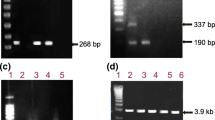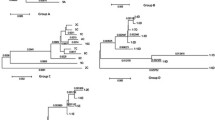Abstract
Each hepatitis B virus (HBV) genotype and subgenotype is associated with a particular geographic distribution, ethnicity, and anthropological history. The present study investigated the genomic characteristics of HBV from Uyghur patients with chronic HBV infection in Xinjiang, China. Among the 53 Uyghur patients enrolled, HBV/D was found to be the dominant strain, with 64.2 % (34/53), 60.4 % (32/53) with HBV/D1 and 3.8 % (2/53) with HBV/D3. In addition to these findings, 3.8 % HBV/B (2/53), 5.7 % HBV/C (3/53), 11.3 % C+D (6/53), 7.5 % B+D (4/53), 3.8 % B+C (2/53) and 3.8 % B+C+D (2/53) were also detected. The full-length genome of seven HBV/D1 isolates and 144 reference sequences retrieved from GenBank were compared and analyzed by biological information methods. These results demonstrate that the D1 isolates from Xinjiang and Central Asia show a close genetic proximity (0.013±0.0007). Furthermore, four unique amino acid substitutions (sp82Asn, sp89His, rt129Leu, rt151Leu) representing background polymorphisms rather than drug resistance mutations or immune escape variants were found in the Uyghur patients of Xinjiang, but these were seldom found in HBV/D1 strains from other regions (0 %-14.3 %). This study indicates that in Xinjiang, unlike HBV-infected Han patients, HBV/D1 is the predominant strain among HBV-infected Uyghur people. Although genetic distance analysis suggests that the HBV/D1 isolates from Xinjiang are closely related to those from Central Asia, unique amino acid substitutions suggest independent evolution of HBV in the Uyghur patients of Xinjiang.



Similar content being viewed by others
Abbreviations
- HBV:
-
Hepatitis B virus
- nPCR:
-
Nested polymerase chain reaction
- PreS/S:
-
PreSurface/Surface
- BCP/PreC:
-
Basal core promoter/PreCore
- ddH2O:
-
Distilled deionized H2O
- sp:
-
Spacer region
- RT:
-
Reverse transcriptase region
References
Michitaka K, Tanaka Y, Horiike N, Duong TN, Chen Y, Matsuura K, Hiasa Y, Mizokami M, Onji M (2006) Tracing the history of hepatitis B virus genotype D in western Japan. J Med Virol 78:44–52
Kramvis A, Kew M, Francois G (2005) Hepatitis B virus genotypes. Vaccine 23:2409–2423
Shi Z, Li X, Ma L, Yang Y (2010) Hepatitis B immunoglobulin injection in pregnancy to interrupt hepatitis B virus mother-to-child transmission-a meta-analysis. Int J Infect Dis 14:e622–e634
Shi Z, Yang Y, Ma L, Li X, Schreiber A (2010) Lamivudine in late pregnancy to interrupt in utero transmission of hepatitis B virus: a systematic review and meta-analysis. Obstet Gynecol 116:147–159
Arauz-Ruiz P, Norder H, Robertson BH, Magnius LO (2002) Genotype H: a new Amerindian genotype of hepatitis B virus revealed in Central America. J Gen Virol 83:2059–2073
Huy TTT, Ngoc TT, Abe K (2008) New complex recombinant genotype of hepatitis B virus identified in Vietnam. J Virol 82:5657–5663
Norder H, Hammas B, Lofdahl S, Courouce AM, Magnius LO (1992) Comparison of the amino acid sequences of nine different serotypes of hepatitis B surface antigen and genomic classification of the corresponding hepatitis B virus strains. J Gen Virol 73:1201–1208
Okamoto H, Tsuda F, Sakugawa H, Sastrosoewignjo RI, Imai M, Miyakawa Y, Mayumi M (1988) Typing hepatitis B virus by homology in nucleotide sequence: comparison of surface antigen subtypes. J Gen Virol 69:2575–2583
Stuyver L, De Gendt S, Van Geyt C, Zoulim F, Fried M, Schinazi RF, Rossau R (2000) A new genotype of hepatitis B virus: complete genome and phylogenetic relatedness. J Gen Virol 81:67–74
Liang XF, Bi SL, Yang WZ, Wang LD, Cui G, Cui FQ, Zhang Y, Liu JH, Gong XH, Chen YS, Wang FZ, Zheng H, Wang F, Guo J, Jia ZY, Ma JC, Wang HQ, Luo HM, Li L, Jin SG, Hadler SC, Wang Y (2009) Epidemiological serosurvey of hepatitis B in China-declining HBV prevalence due to hepatitis B vaccination. Vaccine 27:6550–6557
Li YJ, Zhuang H, Li J, Dong QM, Chen YJ, Niu JQ, Ma WM, Zhao W, Zhao BA, Zhong JQ (2005) Distribution and clinical significance of hepatitis B virus (HBV) genotypes and subtypes in HBV-infected patients. Chin J Hepatol 13:724–729
Gao JW, Li YJ, Zhuang H, Li J, Wang J, Dong QM, Chen YJ, Niu JQ, Ma WM, Zhao W, Zhao BA, Zhong JQ (2007) Distribution of hepatitis B virus genotypes in patients with chronic hepatitis B virus infection among 12 cities in China. Chin J Epidemiol 28:315–318
Zeng G, Wang Z, Wen S, Jiang J, Wang L, Cheng J, Tan D, Xiao F, Ma S, Li W, Luo K, Naoumov NV, Hou J (2005) Geographic distribution, virologic and clinical characteristics of hepatitis B virus genotypes in China. J Viral Hepat 12:609–617
Zhou B, Xiao L, Wang Z, Chang ET, Chen J, Hou J (2011) Geographical and ethnic distribution of the HBV C/D recombinant on the Qinghai-Tibet Plateau. PLoS One 6:e18708
Schaefer S (2007) Hepatitis B virus genotypes in Europe. Hepatol Res 37:S20–S26
Chinese Society of Hepatology and Chinese Society of Infectious Diseases, Chinese Medical Association (2007) Guideline on prevention and treatment of chronic hepatitis B in China (2005). Chin Med J 120:2159–2173
Gunther S, Li BC, Miska S, Kruger DH, Meisel H, Will H (1995) A novel method for efficient amplification of whole hepatitis B virus genomes permits rapid functional analysis and reveals deletion mutants in immunosuppressed patients. J Virol 69:5437–5444
Tallo T, Tefanova V, Priimagi L, Schmidt J, Katargina O, Michailov M, Mukomolov S, Magnius L, Norder H (2008) D2: major subgenotype of hepatitis B virus in Russia and the Baltic region. J Gen Virol 89:1829–1839
Saitou N, Nei M (1987) The neighbor-joining method: a new method for reconstructing phylogenetic trees. Mol Biol Evol 4:406–425
Kimura M (1980) A simple method for estimating evolutionary rates of base substitutions through comparative studies of nucleotide sequences. J Mol Evol 16:111–120
Xu H, Zhang YX, Wei L, Xiao L, Lu XB (2005) Relationship between the genotypes of hepatitis B virus and clinical courses in groups of the Han nationality in XinJiang. J Clin Hepatol 8:11–15
Norder H, Courouce AM, Coursaget P, Echevarria JM, Lee SD, Mushahwar IK, Robertson BH, Locarnini S, Magnius LO (2004) Genetic diversity of hepatitis B virus strains derived worldwide: genotypes, subgenotypes, and HBsAg subtypes. Intervirology 47:289–309
Banerjee A, Kurbanov F, Datta S, Chandra PK, Tanaka Y, Mizokami M, Chakravarty R (2006) Phylogenetic relatedness and genetic diversity of hepatitis B virus isolates in Eastern India. J Med Virol 78:1164–1174
Lusida MI, Nugrahaputra VE, Soetjipto Handajani R, Nagano-Fujii M, Sasayama M, Utsumi T, Hotta H (2008) Novel subgenotypes of hepatitis B virus genotypes C and D in Papua, Indonesia. J Clin Microbiol 46:2160–2166
Meldal BHM, Moula NM, Barnes IHA, Boukef K, Allain JP (2009) A novel hepatitis B virus subgenotype, D7, in Tunisian blood donors. J Gen Virol 90:1622–1628
Chu CJ, Keeffe EB, Han SH, Perrillo RP, Min AD, Soldevila-Pico C, Carey W, Brown RS, Luketic VA, Terrault N, Lok ASF (2003) Hepatitis B virus genotypes in the United States: results of a nationwide study. Gastroenterology 125:444–451
Baig S, Siddiqui A, Chakravarty R, Moatter T (2009) Hepatitis B virus subgenotypes D1 and D3 are prevalent in Pakistan. BMC Res Notes 2:1
Cooksley WGE (2010) Do we need to determine viral genotype in treating chronic hepatitis B? J Viral Hepatitis 17:601–610
Comas D, Calafell F, Mateu E, Perez-Lezaun A, Bosch E, Martinez-Arias R, Clarimon J, Facchini F, Fiori G, Luiselli D, Pettener D, Bertranpetit J (1998) Trading genes along the silk road: mtDNA sequences and the origin of central Asian populations. Am J Hum Genet 63:1824–1838
Chen BF, Liu CJ, Jow GM, Chen PJ, Kao JH, Chen DS (2006) High prevalence and mapping of pre-S deletion in hepatitis B virus carriers with progressive liver diseases. Gastroenterology 130:1153–1168
Ghany M, Liang TJ (2007) Drug targets and molecular mechanisms of drug resistance in chronic hepatitis B. Gastroenterology 132:1574–1585
Bartholomeusz A, Schaefer S (2004) Hepatitis B virus genotypes: comparison of genotyping methods. Rev Med Virol 14:3–16
Naito H, Hayashi S, Abe K (2001) Rapid and specific genotyping system for hepatitis B virus corresponding to six major genotypes by PCR using type-specific primers. J Clin Microbiol 39:362–364
Acknowledgments
We are grateful to Dr. Terri A. Rasmussen from Tulane National Primate Research Center, USA, for proofreading the manuscript. This study was supported by Major Science and Technology Special Project of China Eleventh Five-year Plan (2008ZX10002-001).
Conflicts of interest
The authors declare that they have no conflict of interest.
Author information
Authors and Affiliations
Corresponding authors
Electronic supplementary material
Below is the link to the electronic supplementary material.
Rights and permissions
About this article
Cite this article
Nie, J., Li, J., Sun, K. et al. HBV/D1: a major HBV subgenotype circulating in Uyghur patients with chronic HBV infection in Xinjiang, China. Arch Virol 157, 1541–1549 (2012). https://doi.org/10.1007/s00705-012-1325-8
Received:
Accepted:
Published:
Issue Date:
DOI: https://doi.org/10.1007/s00705-012-1325-8




